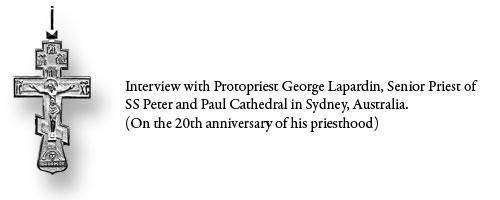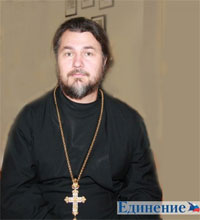
Twenty years ago, Fr George Lapardin began his service at SS Peter and Paul Cathedral in Sydney, Australia. It is difficult to believe that two decades have passed since then.
The last few years, Fr George has been the Senior Priest [klyuchar�] of the main Orthodox church of Sydney. He studied in Holy Trinity Seminary in Jordanville, NY, which has produced almost all of the priests of the Australian Diocese of the Russian Orthodox Church Outside of Russia. Such a high post demands a great deal of work, and the responsibilities are enormous, since the parish is large. But he manages thanks to helpers among the other clerics and members of the Parish Council. His closely-knit family helps, too. Fr George and Matushka Anna have beautiful children�3 daughters and a son. Kind and gentle in nature, one never hears loud speeches or commands, but there within his calmness and certainty is a real pastoral spirit which calls upon his parishioners to actively participate in parish life and fulfill their duties. �
Among Fr George�s talents is one which helps him in one of his important duties, which we asked him about:
 - Fr George, the Cathedral was built over 50 years ago, it is a beautiful edifice, but one feels that the interior is in need of frescoes. I know that you studied icon-painting. - Fr George, the Cathedral was built over 50 years ago, it is a beautiful edifice, but one feels that the interior is in need of frescoes. I know that you studied icon-painting.
- Yes, when 20 years ago Vladyka Paul appointed me to serve at the Cathedral, Fr John Stukach wanted to paint the iconostasis, which was at the time of poor quality. He asked me to begin painting a fresco. Over the course of several years, Antonina Ganina and I worked on it. The idea to paint the rest of the Cathedral lived on among the clergymen and parishioners for a long time, but at first, after the Cathedral was erected, it was difficult to find money to do this, we had other priorities.
Then, in the 1970�s, the parish went through a difficult time, when unity and concord was lost, and the Cathedral was closed for a time. But now we emerged from the so-called �emigre, refugee� mindset. We have established a good foundation for painting frescoes in the Cathedral. I have gone to Russia twice to study the matter, to choose a style, so that the architecture and iconography matched. I also pondered this in Australia. I cannot do the work alone. But there are good iconographers in our Diocese, and we hope to work together. �
Twenty years ago, we had to try and persuade the parishioners that we needed to paint icons for the iconostasis, whereas now the parishioners themselves are asking when we will begin painting the wall frescoes, to give it a warmer atmosphere. Now we have no excuse, we have the money and the icon-painters.
- Do you have an outline of the iconography?�
- It is difficult to plan ahead. Often an icon-painter will develop the style as he works. We are listening to suggestions. Fr Alexis from the monastery is giving a lot of good advice. We have a plan for a mosaic of SS Peter and Paul over the entrance to the Cathedral.
During our last annual meeting, we discussed the option of replacing all the icons that are printed on paper. In addition to old icons which we inherited from parishes which were closed in China or were donated, we have a good number of lithographed icons on paper. They don�t use paper icons in Russia. Since both Australia and Russia have many good icon-painters, it is time to replace the paper icons with real ones painted by master iconographers. �
We also have many duplicate icons, for instance, eight copies of the Kazan Mother of God, while other icons, such as John the Baptist, we only have one in a frame which cannot be placed in the middle of the church on an analogion during his feast day. The Cathedral has a lot of matrimonial icons which were donated to us. They are valuable, of course, in rizas [gold or silver covering], but they are intended for weddings, not for a church. �
Now we are conducting an inventory of all of the icons we want for the Cathedral, and will ask parish families to donate funds for painting one specific icon or some saint or another. Icons are expensive, and we need the parishioners� help. �
- When do you expect work to begin?��
- There is no need to hurry. It is important to do it right. Renovation is a normal part of the life of a church. The first two festive icons of the Triumph of Christ have been painted. For 55 years now, we have had a paper icon placed in the middle of the Cathedral on the Nativity of Christ, in a wooden frame. The same applies to the Epiphany.
I would like to start the fresco in the altar, then proceed with the narthex, then the choir, and only then begin the main church. This order is necessary in order to work out the composition of the iconography, to gather some experience first before proceeding with the nave. So the plan has been launched. We have the support of the parishioners and the Parish Council and the Sisterhood. I must say that the Sisterhood is a great contributor towards the adornment of the church. Parish funds are spent on maintenance, while the Sisterhood moneys cover expenses for the icons, the vestments and church utensils�the crosses, censer, baptismal font and other necessary items.�
- The Cathedral, thank God, is now in a financial position to do the renovations. But in Sydney alone there are eight churches of the ROCOR Diocese. Some of these are small parishes, whose churches are in need of renovation, but naturally, their finances are not very healthy. Some people feel that it might be better to have fewer churches, but that they would then have more people in each.
- Of course, when a church has more people attend services, the spiritual mood is elevated. I heard this same opinion about reducing the number of churches. Vladyka Hilarion has a different opinion. He thinks that we should have more churches in places where Orthodox Christians live, because it is one thing to come to church and pray, and another to participate in the life of the church, hold some kind of office, work for the parish. When a person holds such a post in a church, as a volunteer, then of course he feels himself to be a part of the church. He feels �this is my church.� It holds special value to have more active, and not passive, parishioners in a church.�
�
|- Let�s return to the work on the Cathedral. You studied iconography in Jordanville.�
- Yes, under Archimandrite Kyprian, Hegumen Andre Erastov and then under Antonina Ganina. And I continue to study. This is what art is about, to strive to learn. New techniques in iconography turn up, especially in Russia today. Sometimes these are long-forgotten, ancient methods.
- What kind of paints to you use in the frescoes?�
- Acrylic paint for the church frescoes. The church in Cabramatta is also painted in acrylic. For the icons we use egg tempera. �
�
- What style is Protection Church in Cabramatta painted in? �
- I would say the �Jordanville style.� Of course, the icon painters who painted that church have perfected the style, and execute it in greater perfection. I think that each icon painter constantly seeks something new, he is never satisfied and cannot remain in place.�
- What other churches in the ROCOR parishes of Australia besides Cabramatta have frescoes? �
- St Nicholas in Adelaide. Recently they started painting frescoes in Melbourne and Djeelong. The time has come for us to paint frescoes in the Cathedral.�
- Thank you. Congratulations, Fr George, on your 20th anniversary as a clergyman at the Cathedral. We know that the frescoes will add to your burdens, but I think this is the second most important task after the erection of the Cathedral�s walls 55 years ago, and that it will bring great joy to both the clerics and parishioners. We wish all those participating in this grand project of frescoing the Cathedral walls in Strathfield success.
Interviewed by Vladimir Kuzmin
www.unification.net
|